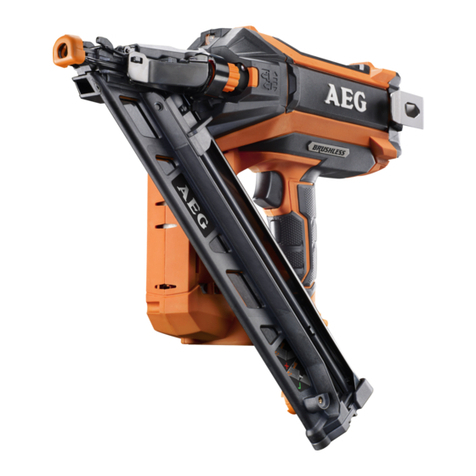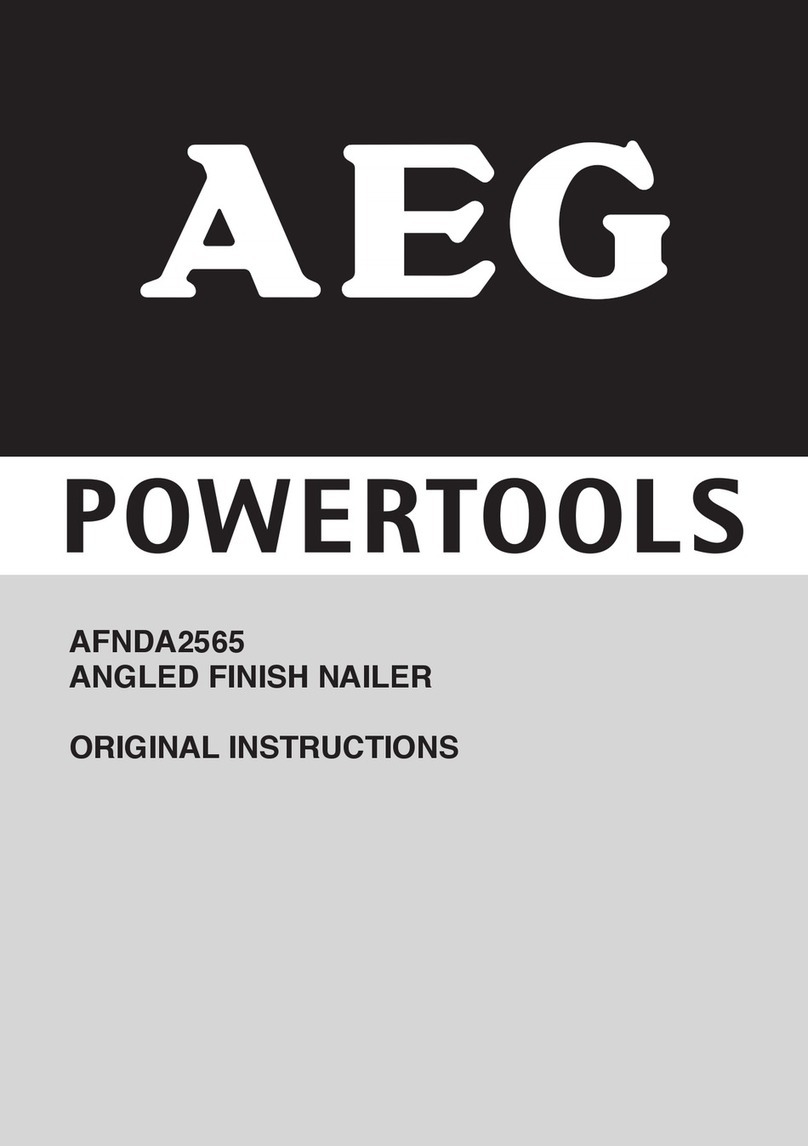
77
location where the temperature is more than 10°C but less than
38°C. Do not store outside or in vehicles.
Under extreme usage or temperature conditions, battery
leakage may occur. If liquid comes in contact with your skin,
wash immediately with soap and water. If liquid gets into your
eyes, ush them with clean water for at least 10 minutes, then
seek immediate medical attention. Following this rule will reduce
the risk of serious personal injury.
Use the tool only for its intended use. Do not discharge fasteners
into open air.
Use the tool only for the purpose for which it was designed.
Use only the fasteners recommended for this tool. Use of the
wrong fasteners could result in poor fastener feeding, jammed
fasteners, and nails leaving the tool at erratic angles. If fasteners
are not feeding smoothly and properly, discontinue their use
immediately. Jammed and improperly feeding fasteners could result
in serious personal injury.
Never use this tool in a manner that could cause a fastener to
be directed toward anything other than the workpiece.
Do not use the tool as a hammer.
Always carry the tool by the handle.
Do not alter or modify this tool from the original design or
function without approval from the manufacturer.
Always be aware that misuse and improper handling of this
tool can cause injury to yourself and others.
Never clamp or tape the trigger or workpiece contact in an
actuated position.
Never leave tool unattended if the battery is installed.
Do not operate this tool if it does not contain a legible warning
label.
OPERATION
Do not use tool if trigger does not actuate properly. Any tool
that cannot be controlled with the trigger is dangerous and must
be repaired.
Check operation of the workpiece contact mechanism
frequently. Do not use the tool if the workpiece contact mechanism
is not working correctly as accidental driving of a fastener may
result. Do not interfere with the proper operation of the workpiece
contact mechanism.
Do not use a tool that does not work correctly.
Always assume that the tool contains nails.
Do not carry the tool from place to place holding the trigger.
Accidental discharge could result.
Always handle the tool with care:
• Respect the tool as a working implement.
• Never engage in horseplay.
• Never pull the trigger unless nose is directed toward the work.
• Keep others a safe distance from the tool while tool is in
operation as accidental actuation may occur, possibly causing
injury.
Choice of triggering method is important. Check manual for
triggering options.
The nailer is designed for single-hand use. Do not hold the tool
by the front of the magazine. Do not put hands, head, or other parts
of your body near the bottom of the magazine where the nail exits
the tool, as serious personal injury could result.
Do not point the tool toward yourself or anyone whether it
contains nails or not.
Do not actuate the tool unless you intend to drive a fastener
into the workpiece.
Always ensure that the workpiece contact is fully positioned
above the workpiece. Positioning the workpiece contact only
partially above the workpiece could cause the fastener to miss the
workpiece completely and result in serious personal injury.
Do not drive nails near edge of material. The workpiece may split
causing the nail to ricochet, injuring you or a co-worker. Be aware
that the fastener may follow the grain of the wood, causing it to
protrude unexpectedly from the side of the work material or deect,
possibly causing injury.
Keep hands and body parts clear of immediate work area. Hold
workpiece with clamps when necessary to keep hands and body out
of potential harm. Be sure the workpiece is properly secured before
pressing the fastener against the material. The workpiece contact
may cause the work material to shift unexpectedly.
Keep face and body parts away from back of the tool cap when
working in restricted areas. Sudden recoil can result in impact to
the body, especially when nailing into hard or dense material.
During normal use the tool will recoil immediately after
driving a fastener. This is a normal function of the tool. Do not
attempt to prevent the recoil by holding the nailer against the work.
Restriction to the recoil can result in a second fastener being driven
from the nailer. Grip the handle rmly, let the tool do the work and
do not place second hand on top of tool or near exhaust at any time.
Failure to heed this warning can result in serious personal injury.
Do not drive fasteners on top of other fasteners or with the
tool at an overly steep angle as this may cause deection of
fasteners which could cause injury.
LOADING TOOL
Do not load the tool with fasteners when any one of the operating
controls is activated.
When loading tool:
■Never place a hand or any part of body in fastener discharge
area of tool.
■Never point tool at anyone.
■Do not pull the trigger or depress the workpiece contact as
accidental actuation may occur, possibly causing injury.
SAVE THESE INSTRUCTIONS
Refer to them frequently and use them to instruct others who
may use this tool. If you loan someone this tool, loan them these
instructions also.
ASSEMBLY
WARNING
Do not use this product if it is not completely assembled or if any
parts appear to be missing or damaged. Use of a product that
is not properly and completely assembled or with damaged or
missing parts could result in serious personal injury.
WARNING
Do not attempt to modify this product or create accessories or
attachments not recommended for use with this product. Any
such alteration or modication is misuse and could result in a
hazardous condition leading to possible serious personal injury.
OPERATION
WARNING
Do not allow familiarity with products to make you careless.
Remember that a careless fraction of a second is sufcient to
inict severe injury.































